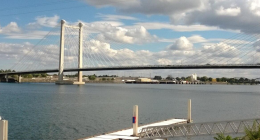The report goes on to state that, in the same period, there is a 66 per cent chance that global surface temperatures will temporarily exceed 1.5 degrees above pre-industrial levels for at least one year.

That 1.5-degree increase is a long-feared mark that was listed as a target that global warming must be limited to under the landmark 2015 Paris Agreement.
While a temporary breach of the mark doesn’t mean the world will have failed to meet the target, the WMO said it is sounding the alarm that it will be breached more and more frequently.
The release of greenhouse gases by burning fossil fuels, and the increasing likelihood of an El Niño developing this year, are the driving factors behind the temperature increases.
“A warming El Niño is expected to develop in the coming months and this will combine with human-induced climate change to push global temperatures into uncharted territory,” WMO Secretary-General Professor Petteri Taalas said.
“This will have far-reaching repercussions for health, food security, water management and the environment.
“We need to be prepared.”

Dr Hamish Clarke, a research fellow in future fire risk at the University of Melbourne, said the report painted a bleak picture of future Australian bushfire seasons and droughts.
“When it comes to bushfire risk, the news that there is a 98 per cent chance of setting a new global temperature record in the next five years is extremely worrying,” he said.
“High temperatures are one of the key ingredients for dangerous fire weather, along with dry and windy conditions.
Read Related Also: Jimmie Allen’s Wife Alexis Gale Unveils Their Third Baby’s Gender Amid Divorce
“As temperatures continue to rise, there is more chance of them coinciding with extended dry spells and droughts.”

Other experts speaking about the report also expressed their concern about the likelihood of drought, while Monash University’s Dr Kimberley Reid said it flagged particularly dire news for one of Australia’s most iconic natural wonders.
“In order for one of the next five years to not be record-breaking, we would either need no El Niño events in the next five years, or a massive volcanic eruption in the tropics, à la Krakatoa in 1883,” Reid said.
“Both are extremely unlikely scenarios.
“My biggest fear is that we become desensitised to the ever-falling records and forget what these numbers actually mean.
“1.5 degrees warming means the Great Barrier Reef probably won’t survive this century. That’s tragic.”

Clarke, meanwhile, said the report highlighted the need for more urgent action to reduce emissions and limit the extent of climate change.
“If we continue on our current path there is a real possibility of a repeat – or worse – of the conditions that led to the devastating Black Summer fires of 2019-20,” he said.
“There is still time to avoid the worst climate change projections but it means taking much more action than we currently are.”

What sea level rise will look like around the globe







